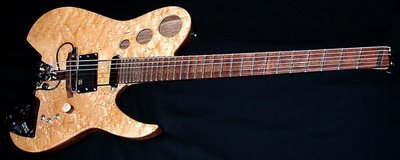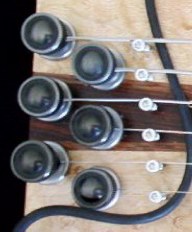Alternative Headless Guitar Design – TK Instruments
As discussed in Headless Guitar Resources for the Guitar Builder, the headless guitar design lends itself to the pursuit of an ergonomic guitar design. With the headstock’s weight removed and the tuners relocated to the body, the guitar’s balance improves significantly. This improvement in balance was one of the driving forces behind Ned Steinberger’s redesign of the bass. With its long neck and heavy tuners, the bass was an obvious choice for such a redesign. The guitar followed suit.
A also noted, headless guitar components can be expensive and difficult to find. Given this issue, I have been researching alternative solutions. One such solution can be seen at TK Instruments in the form of luthier Todd Keehn’s Hollow Body Electric Guitar:


Todd Keehn has solved the tuning issue by using Steinberger Gearless tuners at the body side. These tuners, designed originally as substitutes for conventional guitar tuners, are readily available from outfits such as Stewart-MacDonald and open up a number of alternatives. First, with the use of an appropriate headpiece capturing the ball end of the string, we no longer need double ball end strings. While double ball end strings can be difficult to find at times, conventional strings are available everywhere and in much greater variety. Second, this solution provides us with a way to accommodate a fixed bridge for those of us who aren’t interested in tremolos. The Hollow body, for example, uses a fixed piezo bridge. Third, for those with large hands, the large tuners are less cumbersome to operate than the small tuners on the Steinberger tremolo bridge and its alternatives. Fourth, although not the most inexpensive tuners, these locking tuners are priced comparably to more traditional looking locking tuners.
Finally, if you are at all interested in general guitar design, don’t let my focus on the tuning solution stop you from exploring the other elements on Todd Keehn’s guitars. Check out Anatomy of a TK and discover some of the interesting elements and details he incorporates into his various designs such as compound scale necks or Fanned Frets, stainless steel rod frets, asymmetrical neck profiles, etc.
I like the use of “stock” tuners, but can they be adjusted from the top of the guitar? It looks like you’d actually have to reach behind the guitar to tune it.
You’re right – tuning would require reaching behind the guitar so you would have to consider if that is a show-stopper. For me it isn’t because of the potential benefits of a headless guitar. Also, keep in mind that both the fixed bridge and the locking tuners contribute to greater tuning stability which reduces the need for re-tuning. Thanks for the comment!
Not sure of the best place to post this, but ABM does make single bridges for guitar with tuners: http://www.abmmueller.de/headless_units.htmland then click on the second picture from the right near the bottom. AllParts says they can get them, but it’s a bit over two weeks and I’ve not been able to get a price quote.
Thanks for the link on those bridges. I’ve seen them before on the Novax guitars and they are interesting to say the least. They particularly fit in with the Novax fanned fret concept because of the changing scale lengths for each string.
Hi again!
I have one Klein replica made (from my original) with ABM single string bridge tuners. I live in Sweden but ordered them directly from ABM Germany. Took a couple of weeks though.
Now they are too tight in two ways. First, they can be set at a very narrow string spacing like 12 mm (sorry,don’t know that in inch) but if done so the actual tuning screw – that is jagged – will touch the neighboring ones. This is also true to their BASS bridges, single ones that is needed to fit perfect with a Steinberger neck. If they’re at 17 mm the actual tuners makes contact with each other! 😕
And, my big problem with double ball end strings is that ABM bridges can’t move FORWARD enough to let the whole ball slip into the slot easily while changing strings. It’s too tight, and there may not be enough room to intonate either. I have to turn the strings around so that THE SMALLER SIZED BALL fits into it’s slot. This generates other problems such as lock windings of the strings protrudes over the zero fret and so on. This applies both to their fixed bridges and their single ones. I have a bass with ABM as well, so I know. However, when using single ball end strings, this is no problem.
So there are a slight caveat emptor when buying ABM. ABMs material though, is rock solid, and German high quality steel. And sustains “forever”.
However, ergonomics in headless designs are those that: The body/neck (i e the whole guitar!) should “end” where the strings ends!
Any material, bridge, tuners, etc, that comes behind or in front of that are unefficient, and un-rational. The excess string length that is wound up on tuners of a regular headstock guitar are a complete waste, both in staying in tune, and time to tune it up.
Great feedback on the ABM bridges! I’d love to see some images of the guitar if you have them available.
I will make photographs of abm bridges, and the Klein replica. Will return
I’m looking forward to it!
An idea for experimenting – The Musicyo GT-Pro (the “broom” shaped headless) is neck through with small wings. Plane or saw the wings flat (remove the edge radius) and add wings to make the Klein type shape and angle as desired and refinish. The tuners, trem and headless setup are already there and D’addario, GHS and others make the double ball strings. I’ve owned both the GT-Pro and GU models and they are built like a rock and play great.
I’ve actually toyed with that idea, John. I own a Hohner G2T which is very much like the GT-Pro. It sits quietly in its case most of the time now but I still have a soft spot for it so I can’t bring myself to hack it up. However, I’ve thought about building what amounts to a neck through with pickups so I can experiment with various wings as you suggest. I’m still keeping the idea alive for a future guitar project…